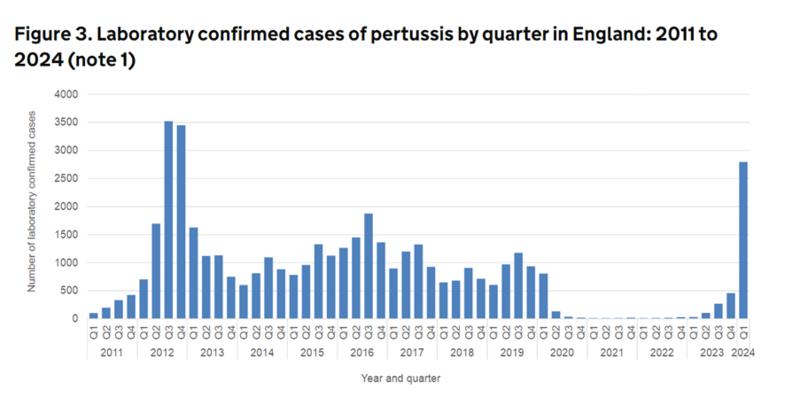|
Pertussis, better known as whooping cough, is a highly infectious disease caused by the bacterium – Bordetella pertussis. Pertussis can lead to serious complications, including death, particularly among babies under the age of six months old and in early life before they are vaccinated. Although pertussis is a major cause of infant death worldwide, the precise number of cases is unknown because many cases go undiagnosed. There is wide variation between the numbers of actual reported cases and data from models that make assumptions about actual infection rates, vaccination coverage and so for. For example, the World Health Organization reported around 151,000 cases worldwide in 2018, whereas an analysis of modelling data from the Global Burden of Disease study estimates that there were around 19 million cases, across all ages, for 2019. What is clear is that parts of the world, including the UK, other European countries and the USA, are experiencing an uptick in the number of pertussis cases during 2024. In England, between January and May 2024, there were 7,599 confirmed cases reported to the UK Health Security Agency, with eight infant deaths over the same time. In all, there have been nine infant deaths since this outbreak began. By contrast, there were just 858 cases reported during the whole of 2023. Pertussis is a cyclical disease, with outbreaks every three to five years. The last nationwide outbreak was in 2012, when there were over 9,300 cases in England alone – this was more than ten times as many as in recent years. During the 2012 outbreak 14 babies under three months old died. There was a less marked increase in cases in 2016 but another 18 infants died between 2013 and 2016. During the COVID-19 pandemic, the lockdowns resulted in less cases due to reduced transmission of the bacterium. Vaccination of people who are pregnant with a pertussis vaccine generates antibodies, which then cross the placenta to the baby before birth. These protect the babies from pertussis infection in the weeks before they are old enough to get vaccinated. However, the number of pregnant women, babies and young children getting vaccinated against pertussis has fallen in recent years across England. Maternal vaccine uptake fell from 74.7% of all pregnant women in December 2017 to 59.5% in December 2023. See more information on the pertussis (whooping cough) vaccination programme for pregnant women. According to the World Health Organization, globally 84% of children under the age of one year received three doses of a pertussis-containing vaccine during 2023. This is 2% less than in 2019, although slightly up from the end of the COVID-19 pandemic. The WHO target is 95%.

|



